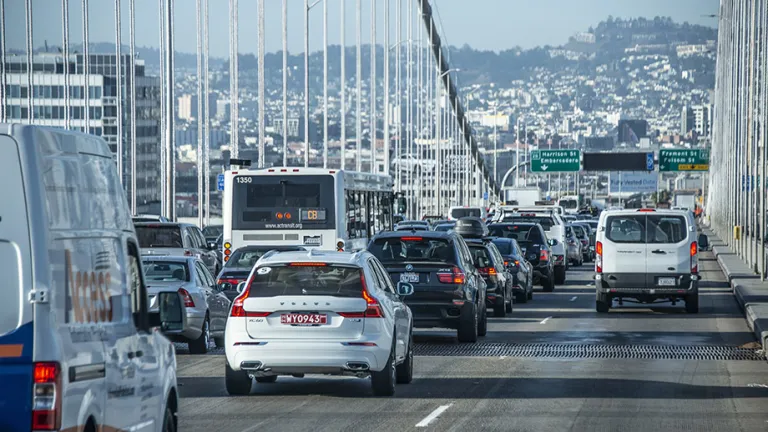SB 743 (LOS to VMT Transition)
To fight greenhouse gas emissions, Senate Bill 743 is working to reduce the amount of driving.
Local agency staff: Get more details and resources on the SB 743 (LOS to VMT Transition) at the Technical Assistance Portal on abag.ca.gov.
Transportation — and particularly passenger cars — is responsible for 40% of all greenhouse gas emissions in the Bay Area.
To reduce this pollution, Senate Bill 743 works with the California Environmental Quality Act (CEQA) to prioritize development and transportation projects that get people out of individual cars and into sustainable modes of transportation.
By reducing the number of vehicle miles traveled (VMT), we reduce the amount of air pollution from cars.
See how the Bay Area fares when it comes to maintaining clean air.

Vehicle Miles Traveled
SB 743, which took effect July 1, 2020, helps reduce transportation’s impacts on the environment.
Before July 1, 2020, traffic congestion levels (known as level of service, or LOS) were the main measurement to determine the negative environmental impacts of development and transportation projects.
Under SB 743, these effects are now measured according to the overall amount that people drive (known as vehicle-miles traveled, or VMT).
VMT is calculated as part of a building or transportation project’s CEQA environmental review process.
Read the full text of the SB 743 bill.
Alignment with Long-Term Regional Planning
By focusing growth in Priority Development Areas and investing in multi-modal transportation programs and infrastructure, SB 743 will help reduce overall greenhouse gas emissions.
These goals are in alignment with the strategies outlined in the region’s long-term transportation and housing plan, Plan Bay Area.
How far do people travel when they get behind the wheel in the Bay Area?

Guidelines for implementation were adopted in 2018 through new CEQA regulations. The guidelines balance the need to manage congestion, statewide goals related to infill development, transit investments, promotion of public health through active transportation and reduction of greenhouse gas emissions.
The information below is targeted toward Lead Agencies, defined by CEQA as a public agency that has the primary responsibility for carrying out or approving a project.
Note: Each lead agency should consult with CEQA experts and legal counsel regarding local CEQA practices and updates to local policies. These documents provide guidance, but are not legal documents or legal interpretations of the law.
Read the Guidelines for implementation.
The resources below provide background and context related to SB 743 and rationale behind the shift from Level of Service (LOS) to Vehicle Miles Traveled (VMT):
- Technical advisory and other resources on SB 743 on OPR's website
- Background on VMT and LOS:
- Problems with LOS (OPR)
- What is VMT (Fehr & Peers)
- Benefits of VMT (OPR)
- Methods for Land Use Projects (OPR)
- Full Counting of VMT (OPR)
- Caltrans SB 743 Implementation
- VTA Level of Service (LOS) to Vehicle Miles Traveled (VMT) Transition resources
- SB 743 Case Studies
In an effort to assist local jurisdictions with SB 743 implementation, MTC is providing technical assistance through its Priority Development Area (PDA) Technical and Staffing Assistance Program and other initiatives. Based on the outcomes and lessons of these efforts, MTC created the following resources that may be helpful to jurisdictions as they transition from LOS to VMT:
- Key SB 743 Implementation Steps for Land Use Projects
- Bay Area SB 743 implementation examples funded through MTC’s PDA Technical/Staffing Assistance Program (check back as additional materials become available as cities move through the process):
- Planning Innovations Workshop 7: SB 743 Implementation Strategies: Moving from LOS to VMT - Part II: Show Me the (Fee) Money!
- Santa Clara Valley Transportation Authority’s (VTA) Countywide VMT Evaluation Tool for local jurisdictions and developers to estimate VMT for land use projects and calculating reductions associated with VMT-reducing measures

